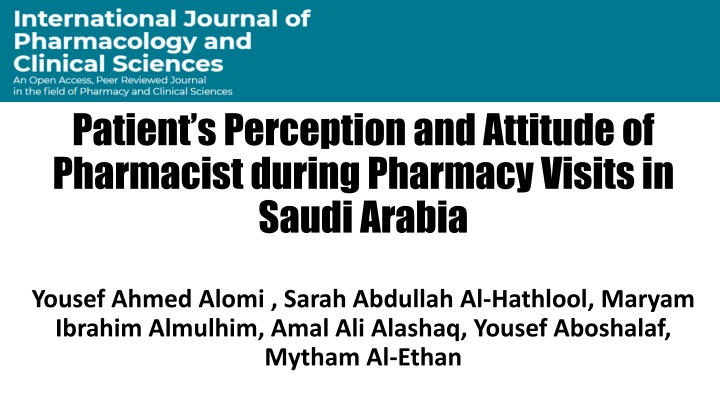
Patients Perception and Attitude of Pharmacist in Saudi Arabia Study
Explore patient perception and attitude towards pharmacists during pharmacy visits in Saudi Arabia. Results indicate areas for improvement in communication and counseling to enhance patient satisfaction.
Download Presentation

Please find below an Image/Link to download the presentation.
The content on the website is provided AS IS for your information and personal use only. It may not be sold, licensed, or shared on other websites without obtaining consent from the author. If you encounter any issues during the download, it is possible that the publisher has removed the file from their server.
You are allowed to download the files provided on this website for personal or commercial use, subject to the condition that they are used lawfully. All files are the property of their respective owners.
The content on the website is provided AS IS for your information and personal use only. It may not be sold, licensed, or shared on other websites without obtaining consent from the author.
E N D
Presentation Transcript
Patients Perception and Attitude of Pharmacist during Pharmacy Visits in Saudi Arabia Yousef Ahmed Alomi , Sarah Abdullah Al-Hathlool, Maryam Ibrahim Almulhim, Amal Ali Alashaq, Yousef Aboshalaf, Mytham Al-Ethan
ABSTRACT ABSTRACT: : Purpose Purpose: : To explore patient s perception and attitude during pharmacy visit in Saudi Arabia. Methods Methods: : This is a 4-month cross-sectional survey of patient perception regarding pharmacists. The survey consisted of two parts: the first part captures demographic information and the second part is a questionnaire with 49 questions divided into four domains: (1) The first domain is regarding patient s general perception of the pharmacist; (2) the second domain captures data of patient s perception regarding pharmaceutical care services; (3) the third domain is regarding patient s perception of visiting ambulatory care; and (4) the fourth domain captures information on patient's perception regarding the pharmacist s relationship and counseling skills. We used the 5-point Likert response scale system to obtain responses of the participants. There were open- and close-ended questions. The survey was distributed through social media to a 500-bed general hospital in Alhassa region, an ambulatory care pharmacy. The authors interviewed the patients with an electronic survey documentation. The survey analyzed domain three, which is about the patient s perception of visiting ambulatory care through Survey Monkey system.
Results Results: : A total of 617 patients responded to the survey. Of them, 536 (87.7%) were Saudi and 75 (12.3%) were non-Saudi nationals. There were 457 (74.1%) female and 160 (25.9%) male responders. In the past 12 months, most of the patients (222 (36%)) visited the pharmacy more than 10 times, whereas the others (122 (19.8%)) visited the pharmacy at least 5 9 times. Most of the patients (481 (83.5%)) spent less than 11 min with the pharmacist. The average score of patients general perception of the pharmacist during pharmacy visit was 3.74. The highest score was obtained for the statements received all medications prescribed to me (4.16) and pharmacy convenient located (4.0).4 The lowest score was obtained for the statement pharmacy waiting area convenient located (3.38). The average score of patient perception of the pharmacist with drug monitoring during the pharmacy visit was 3.74. The highest score was obtained for the statement the patient revived a copy of prescription-contained medications (3.4), whereas the lowest score was obtained for the statement the pharmacist gives a follow-up call to the patient as medications prescribed (2.09). The score for general evaluation of pharmacy visit was found to be 3.67 with a score of (3.55) for the preference to visit the pharmacy or recommendation to other patients or friends.
Conclusion Conclusion: : According to our results, patient s perception during pharmacy visit was found to communication methods and counseling place missed. Corrections of patient needs will improve patient's perceptions and raise patient satisfaction during visiting of pharmacy. be acceptable. Pharmacy
CONCLUSION CONCLUSION The patient s perception of a pharmacist during pharmacy visit was found to be neutral despite some factors being missed related to drug therapy monitoring. Targeting to improve the medication non adherence and reconciliation are highly recommended to improve patient s perception of pharmacist during pharmacy visit in the Kingdom of Saudi Arabia.
